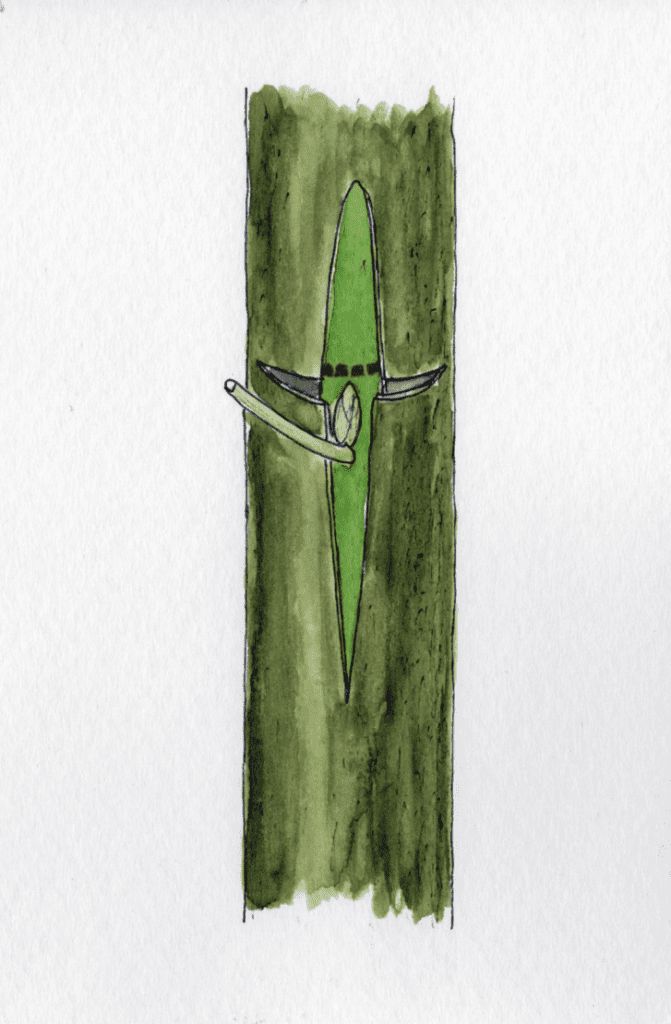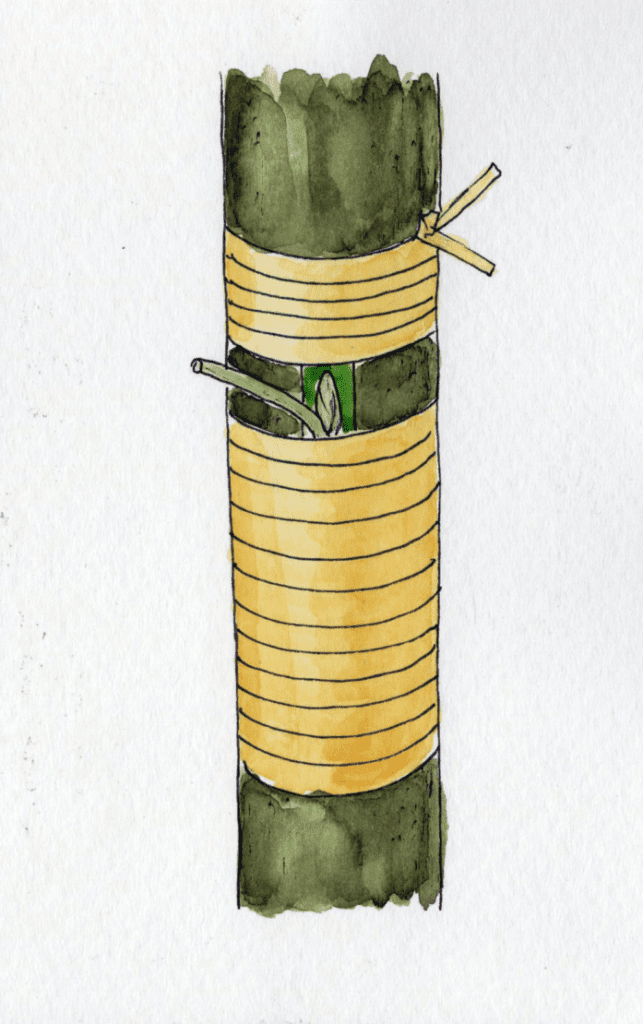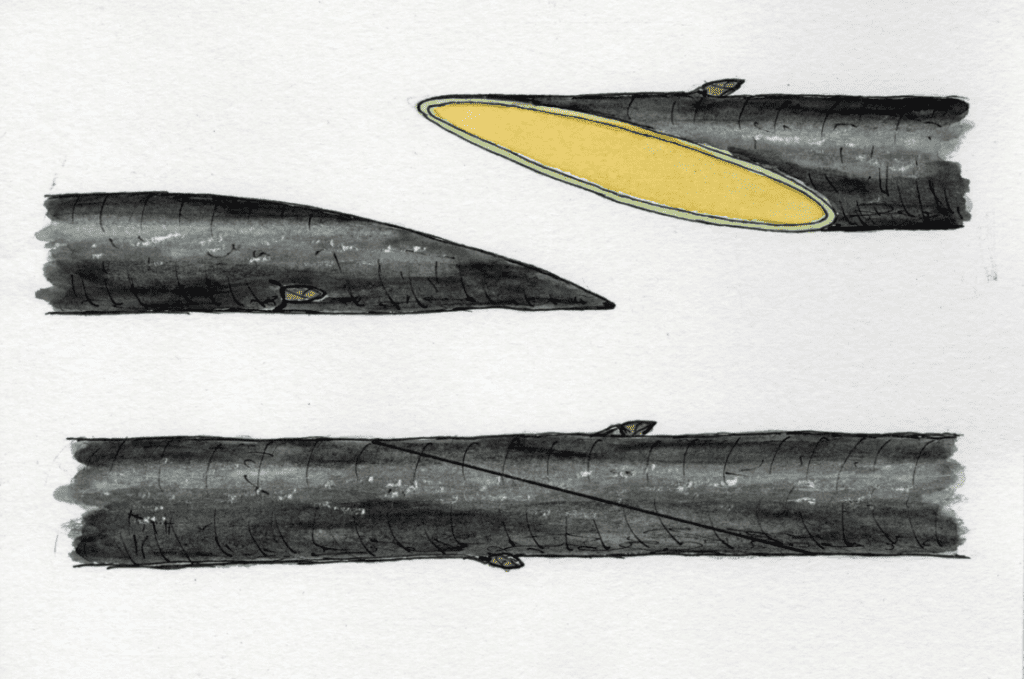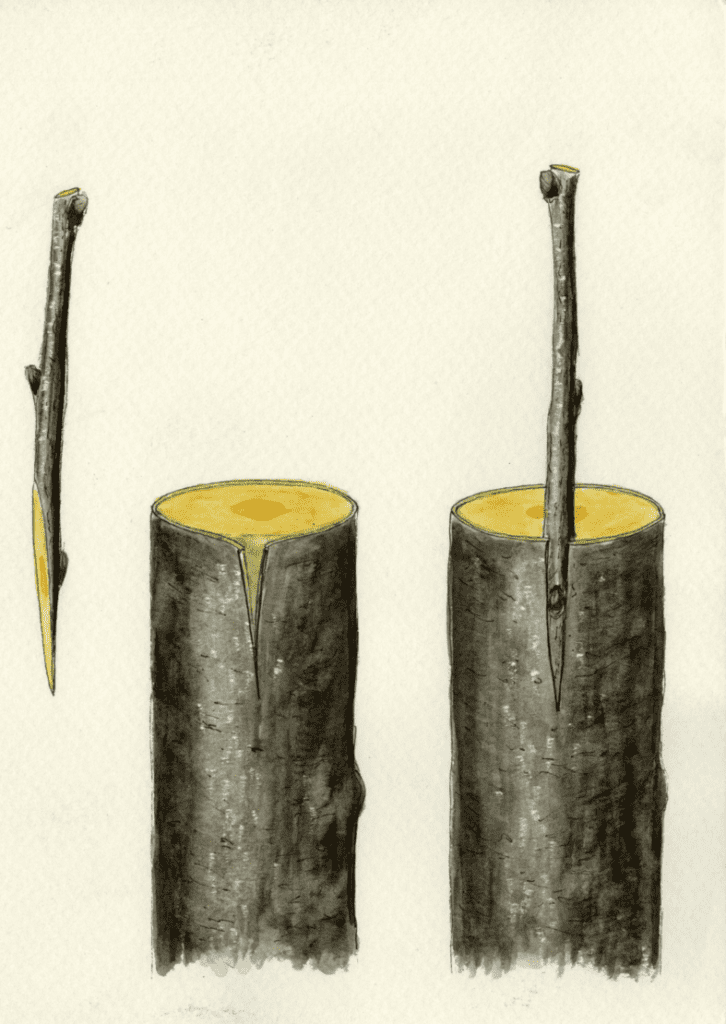Plant grafting is a particularly fascinating method of horticultural propagation. Accuracy and skill are required, as well as the necessary knowledge, of course. Grafting is used on a large scale in tree nurseries and fruit, rose and vegetable farms. But amateur gardeners can also try it and graft trees in their own gardens, for example. The two most important and most frequently used grafting techniques on woody plants are called occulation and copulation.
Contents
What is grafting?
When grafting trees, two different woody plants are joined in a certain way so that they grow together and end up forming a single plant. The two initial plants are called the rootstock and the noble variety. For example, the root part of one tree is combined with the shoot of the other. In the case of trees, this is usually done by grafting a desired variety at the base of the trunk, so that eventually both trunk and crown have the genetic material of the noble variety, but the roots still have the characteristics of the rootstock.
In fact, this type of vegetative propagation is not entirely uncomplicated – especially compared to the usually simple cuttings propagation. Several steps at the right time are necessary for successful grafting. Nevertheless, there are many good reasons why trees and other plants are grafted.
Reasons for grafting trees
There are many variations and reasons for grafting. Grafting makes sense, for example, when certain plants cannot be propagated by other means. Many exquisite cultivars also have the property of producing seeds whose seedlings vary greatly in appearance. Blood beeches, for example, are a happy mutation of the common beech that delight with purple foliage. However, seedlings of this blood beech would very probably not all have equally red leaves. In order to guarantee the colour of the foliage when propagating further, grafting is the safer option. Sometimes grafting is also intended to ensure that a particular variety can grow in a location that is actually unsuitable, for example on very sandy soils. In other cases, the properties of the rootstock are supposed to influence the noble variety. A weak-growing rootstock can make it possible to plant strong-growing varieties in small gardens.
Grafting trees: Three important types of grafting
The type of grafting depends on the particular plant and is also linked to the season and weather. Three of the most important methods are occulation, copulation and honeysuckle grafting. The former takes place in summer, the latter two in winter.
Scion
A scion is a branch of the noble variety. When taking this scion, care must be taken to ensure that the shoots are free of pests and diseases and that they have also grown vigorously. The bending test shows which parts of the branch have the right maturity. Young shoot tips are often still too soft, while the lowest eyes are usually too weak. Both ends are therefore cut off, leaving only the middle part with three to five eyes. If kept moist and cool, the shoots can also be stored for a while.
Occulation


Grafting is probably the most common method of grafting trees. For this, an eye (a bud) of the desired species, variety or hybrid is pushed under the bark of the rootstock so that it can grow and sprout there. The eye is taken from a previously harvested scion with a special budding knife. A T-shaped cut is made on the rootstock, the bark is carefully lifted and the eye is inserted there. Afterwards, the construction is tied so that it holds and is protected from drying out, for example with special rubber or foil bands. The eye remains free so that it can sprout unhindered. The cambium, i.e. the cell-dividing tissue of the two plants, must lie firmly on top of each other in order to fuse securely.
The right time is of great importance, as the success of the procedure depends on whether the bark of the rootstock can be loosened and lifted easily. The chances of this are highest at the beginning or during the growing season, when the metabolic processes are in full swing. Too early an occulation can lead to frost damage to the inserted eye, and at too late a time the bark of the rootstock may no longer be able to be loosened without damage.
Copulation
In contrast to the occulation, not only an eye, but a whole scion is “transplanted” onto the rootstock. Copulation is also used to graft numerous trees during the winter months.
In order for the rootstock and the scion to fit together, they must have a similar diameter. If the rootstock is slightly thicker, it will still work. Relatively steep, long cuts are made on both woody plants. The cut surfaces should be smooth and even. For the cuts on scion and rootstock you need a very sharp knife with a straight edge, a so-called copulation knife. Grafting knives are ground on one side, one side flat, the other curved. That is why there are left-handed and right-handed models.

When grafting trees, the angles of the two cuts should be approximately the same so that the two parts fit together as tightly as possible – the more cambium touches, the more secure the grafting. It is important to cut the scion on the correct side and place it on the tree. The buds should point upwards. Copulated graftings are also joined with raffia or special rubber bands. In addition, the cut ends are often spread with tree or vine wax. The upper end of the scion is also cut again at the end, namely diagonally to the uppermost healthy eye.
Field and hand grafting
The copulation method is used both in the field and for hand grafting. In the open field, the scion is placed on already planted rootstocks. Hand grafting means that both rootstock and scion are held in the hands. The rootstock then often consists of root and stem base.
Honeysuckle grafting
Honeysuckle grafting also uses a whole scion. However, it differs from copulation in the way it is cut. The advantage is that the scion can be much thinner than the rootstock. This is because a wedge-shaped depression is cut into the rootstock, into which the rice is inserted. This is also sharpened into a wedge shape beforehand. To do this, first make the typical copulation cut, then a second cut at right angles to it. The length and width of the rice should roughly correspond to the notch in the wood of the rootstock so that the two fit into each other. An even simpler variant is to push a flat cut wood behind the bark of the underlay, as shown in the illustration. In any case, the two are joined together.
Grafting trees: fruit trees
Grafting is often used for fruit trees. In addition to stability and vigour of growth, the rootstock can also influence fruit yields. Formerly called a wildling, today called a rootstock – this is the rootstock onto which a noble variety can be grafted. A fruit rootstock is either a seedling or has been vegetatively propagated itself. The noble variety determines the fruit characteristics, the rootstock influences the vigour of growth and characteristics such as fruit size.
Example: The apple variety ‘Pinova’ forms small trees with large fruits on the apple rootstock M9. On an apple seedling, on the other hand, strong-growing, large trees with numerous, rather small apples develop.
Grafting fruit trees can also be beneficial in private gardens. For example, grafting can save old varieties that are no longer available for sale. A scion of the old tree may continue to grow on a different rootstock. If you are not confident enough to do it yourself, you can also turn to tree nurseries or fruit companies. Many of them offer to do the grafting for you and can also pick out the suitable rootstock.
Cleanliness and accuracy

When grafting, work must always be done carefully, precisely and cleanly. Apart from the right season and weather conditions and the correct removal of the scions, clean, preferably disinfected, tools are also of great importance. Do not touch the cuttings, otherwise bacteria can get into the cambium. When grafting, the grafting site is also cleaned beforehand.
Existing fruit trees can be spiced up by grafting new varieties at different points in the crown. For example, different fruit varieties with different characteristics can grow on one and the same apple tree – this is then a so-called family tree. For copulation, look for a shoot in the fruit tree crown that is as thick as your scion. If the rootstock is twice to about four times as thick as the scion, you can try grafting honeysuckle. It is best to practise the demanding technique first with the soft shoots of willow or lime until you have mastered the pruning technique.
Who goes with whom?
Not all plants can be combined in this way. Only closely related genera or species have the possibility to grow stably together. The closer the degree of relationship, the greater the chances of success. The minimum requirement is that both belong to the same plant family. Pears, for example, are often grafted onto quinces, both of which belong to the rose family (Rosaceae). Pear is also compatible with other pears, as well as with hawthorn. Apple grows well with apple, cherry with cherry and plum with other plums, peaches, apricots and nectarines. But there are also certain incompatibilities, when two simply cannot get along, for example plums and apricots.

